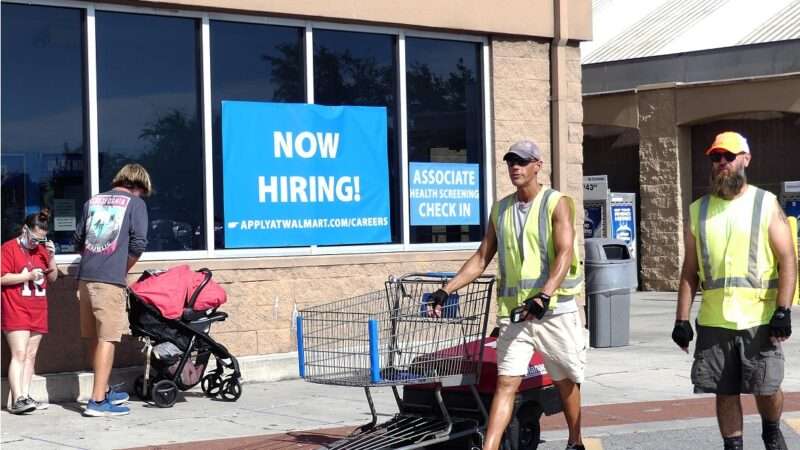
Amid rising concerns that workers are choosing to remain unemployed during the economic recovery, the May jobs report released on Friday doesn’t offer much reassurance. Many labor market watchers will be quick to latch onto the seemingly good news that (1) payroll job growth almost matched economists’ expectations (559,000 new jobs were reported, rather than 650,000) and (2) that the official unemployment rate dropped by 0.3 percentage points. However, the deeper data indicate that fears about labor supply problems, at least during this early stage of the recovery, are justified.
Before we start pointing fingers at potential culprits—I anticipate that you’re already gathering the tar and feathers to give expanded unemployment insurance benefits their comeuppance—it’s worthwhile, in the name of intellectual honesty, to explore other potential explanations.
For example, perhaps the unusually low job growth in the April report—which was quite a letdown—was a statistical blip caused by survey results that don’t accurately reflect reality. If that’s the case, we’d expect to see the following month return to the same trend as previous months. However, that hasn’t happened. The May jobs report did show a respectable increase in the number of employed workers and the number of payroll jobs, but there wasn’t a surge to make up for April’s anemic growth. Nor did the regular update to the April data show much of an increase.
Alternatively, perhaps the seasonal adjustments that the Bureau of Labor Statistics applied to the data concealed a larger increase than actually occurred. Seasonal adjustments ensure that month-to-month results are comparable. Otherwise, the drawdown in holiday-season jobs would make each January look like the start of a recession. Although the raw data do show that more jobs were created in April than the seasonal adjustment suggests, this was also the case for the previous months and for May. There’s no aberration here to explain the underwhelming report.
Furthermore, the raw job growth in April 2021 actually looks pretty similar to the raw job growth during April 2017, 2018, and 2019. That fact itself suggests the presence of a serious problem: During the initial stages of this economic recovery, we should expect to see job growth that is substantially faster than before the pandemic, when the economy was at full employment.
Because there doesn’t seem to be anything statistically wrong with the jobs data, it’s worth getting a little worried about the pace of the labor market’s recovery. And the rest of the news from the May jobs report is even more concerning.
For example, the substantial decline in the official unemployment rate—which is normally a cause for celebration—is troubling. If jobless workers were shifting toward getting out of the house and back into the economy, we should see unemployment rising as people reenter the workforce and look for jobs. Given that vaccines had been widely available for a month prior to the collection of May’s employment data, and that most lockdown measures had been or were in the process of being repealed, there should be some initial sign of workers rejoining the labor market.
But the number of people who were officially counted as unemployed—jobless workers who are actively looking for work—dropped by almost 500,000. And because the majority of those seemed to be workers who were on temporary layoff, there are a lot of people who just aren’t rejoining the labor market.
Here’s a metaphor that better explains what I mean. Imagine the labor market as a sporting event. The players on the field are employed workers. Players standing on the sidelines, holding their hands up and shouting “Put me in, coach!” are the unemployed workers actively looking for jobs. Then there are players—perhaps injured, catching their breath, or just content to sit things out—who are seated on the bench. Meanwhile, retirees and children watch from the stands.
Currently, the labor market has as many as 5.75 million more workers seated securely on the bench than were there prior to the pandemic. The workforce is still 3.5 million workers smaller than it was in February 2020, and another 2.25 million young people have come of working age over the last 15 months. But for some reason, the players on the bench seem to be mostly staying put instead of letting the coach know they’re ready to play.
There are a number of good reasons why they might do so. They could be caring for family due to pandemic restrictions on in-person schooling, enjoying an early retirement, or waiting for the right job to open up. However, even the largest estimates of early retirees only account for 1.7 million people leaving the workforce, and recent research suggests that child care isn’t restricting the return to work.
That seems to leave the federal expansion of unemployment insurance as a major driver of workers’ decisions to remain on the sidelines.
This question is likely to be decided over the next two months. Twenty-four states have announced an early end to their participation in the federal expansion to unemployment insurance. If we see these states experience more employment growth than other states, we’ll have a pretty clear idea of what the culprit was. Stay tuned.
from Latest – Reason.com https://ift.tt/3gcfU7G
via IFTTT